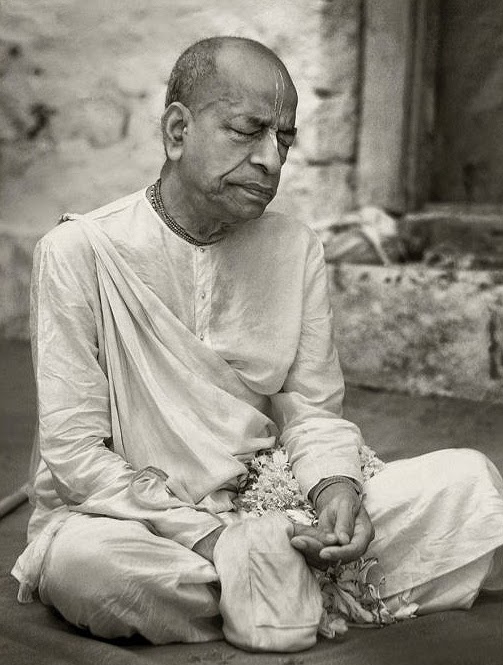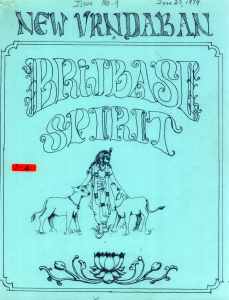What is their conception of Vishnu?
How is Mayavada offensive?
How is chanting in the washroom not an offense to the holy name?
→ The Spiritual Scientist
I have heard the story of Gopal Guru Goswami and Lord Chaitanya, but I don't find it philosophically convincing. When we don't take the Deity to the washroom, how can we take the namavatar to the washroom?
When chanting requires mind control, why do we say that chanting leads to mind control?
→ The Spiritual Scientist
Words shape worlds – watch your words
→ The Spiritual Scientist
“Speak when you are angry and you’ll make the best speech you’ll ever regret.”
- Laurence J Peter, Canadian Educator
“Austerity of speech consists in speaking words that are truthful, pleasing, beneficial, and not agitating to others, and also in regularly reciting Vedic literature.”
- Bhagavad-gita 17.15
Leaders need to inspire, guide and, at times, correct those whom they lead. All this requires good communication. Throughout history, reformers, revolutionaries, pioneers and other leaders have used effective communication as a central tool for actualizing their mission. Indeed, it is no overstatement that words have shaped worlds – and will continue to do so for all time to come.
But effective communication is not easy. Communication doesn’t happen merely by our sending the right message – it happens when our message is rightly understood. Without effective communication skills, leaders will be talking past others. No matter how visionary they may be, others won’t buy into their vision and they will feel as if they are alone, trying to do things right with no one understanding or cooperating.
To avoid such isolation and irritation, leaders need to learn better communication. The Gita vividly exemplifies effective communication, wherein Krishna restored confused Arjuna’s determination through a succinct yet profound conversation.
Communication is both verbal and non-verbal. Verbal communication centers on words, which are indispensable tools for conveying our ideas and feelings to others. These linguistic tools have become increasingly critical in our hi-tech age of phones and emails that often don’t allow the non-verbal forms of communication that nuance, soften, qualify or otherwise complement verbal communication in face-to-face conversations.
Choose words that connect, not alienate
Among the many roles that words can play in conversations, two prominent ones are as windows and as walls. As windows, words give others a clear view of our thoughts and feelings, thereby facilitating understanding. As walls, they block others’ vision of our perspective, thereby breeding misunderstandings.
How can we ensure that our words act as windows, not walls?
By applying the guidelines of the Bhagavad-gita (17.15) for tapping the power of words: speak words that are non-agitating, truthful, pleasing, beneficial and scripturally based.
Let’s focus on the first guideline. When we speak in ways that agitate others, their emotions rise as instinctive reflexes for self-defense. This relegates their rational faculty to the background, making a calm, intelligent discussion nearly impossible. Soon the conversation degenerates into a shouting match or a name-calling competition. Subordinates may not vent their feelings, but they will become emotionally closed to our inputs. Over time, our words will end as bricks in the Chinese wall that builds up between them and us.
To avoid such confrontations, do we have to suppress genuine facts or concerns?
No, because the same Gita verse also urges us to speak truthfully. The recommendation that we speak gently is meant to ensure that the form of our message doesn’t unnecessarily alienate others from its content.
How do we balance sensitiveness and truthfulness?
By calmness and prayerfulness.
Before starting a high-stakes conversation, we can pause to gather our spiritual bearings, remind ourselves that this situation, like all situations, is ultimately Krishna’s arrangement to deepen our wisdom, and pray for his guidance. The resulting inner peace and poise will help us find words that break walls and build windows.
Tap the power of divine sounds
Significantly, the Gita (17.15) refers to speaking properly as an austerity or a discipline. That proper speech is a discipline implies that it doesn’t come automatically – it has to be cultivated consciously and conscientiously.
Lack of verbal discipline can have grave consequences, as most of us have probably witnessed or even experienced. Harsh words can break hearts and wreck relationships. Even when the effects are not so devastating, still, thoughtless words can intensely scar others’ hearts. These scars are often severe and sometimes incurable, especially if the inconsiderate words come from people held in high regard. The words we speak are powerful weapons akin to arrows – arrows that once released from the string of our tongue can’t be withdrawn.
It’s not that we aren’t aware of these dire consequences of inconsiderate words. In fact, it’s often such awareness that makes us resolve to refrain from impulsive harsh speech. Yet, during demanding situations, we frequently find ourselves, to our dismay, lashing out with the very kind of words we had resolved to avoid.
During the heat of the moment how can we check ourselves?
By tapping the power of divine sounds.
The same Gita verse also mentions regular recitation of scriptures as the final discipline of speech. This verbal discipline reveals the secret that can empower us to follow the preceding disciplines. When we regularly recite scriptures and also the holy names of Krishna that are the conclusive gist of scriptures, we become connected with his almighty power. This power enables us to take charge of ourselves when our lower self incites us to speak insensitively.
We can use whatever willpower we presently have to cultivate this empowering discipline of reciting divine sounds – both on a regular basis and especially when we feel provoked.
How can we recite scripture in the corporate settings where we often get provoked? When we are annoyed or angered, it’s best to delay giving feedback because in that frame of mind we will most likely over-criticize and under-help others. We can take brief breaks wherein we can recite divine sounds softly. When that’s not possible, we may take just a few deep breaths wherein we recite or contemplate in the mind. Even such small investments in connecting with divine sounds can give big dividends in terms of calming us and enabling us to choose judicious words. Practicing such discipline steadily will reshape our regular speech so that it strengthens, not weakens, our relationships.
Speak the unpalatable truth palatably
An indispensable aspect of leadership is correcting subordinates when they go wrong. Our criticism can be either constructive or destructive depending on whether it inspires those corrected to improve or impels them to become defensive and reactive. We can’t determine the way people respond to our feedback – that is determined by their volition. Still we often play a bigger role in determining their response than what we might presume. People respond not just to what we speak, but also how and why we speak. They sense whether we actually want to help them or whether we delight in pointing out their faults.
Leaders may well rationalize their insensitivity: “If people can’t take feedback positively, they can just go find another job. I don’t have the time to mollycoddle them – I have projects to complete and deadlines to meet.”
Yes, we do have projects to complete, but ultimately we can’t do those projects without people. And each time we lose a team member, we need to find a new person and spend time, energy and money on training. If people regularly leave because they find working with us too difficult, then the fault may not lie as much in their incompetence as in our harsh speech. For any organization functioning in a competitive world, high staff turnover is a decided disadvantage. Just as we work to fix other weaknesses in our organization, we need to minimize the turnover too. And we can do that by learning to moderate our speech.
Being sensitive is not about mollycoddling people – it is about helping them in their learning or at least not increasing the obstacles in their learning. Pertinently, the Gita (17.15) urges us to speak not just truthfully but also palatably. Translated to our context, this means that we not only tell others their faults when necessary but also do so as palatably as possible.
Palatable speech can do much more than retain people – it can motivate them to higher levels of performance. What most inspires people to perform is not remuneration, but appreciation. When people are paid, they bring their hands to work, maybe even their head if their work is intellectual. But when people feel valued, they bring their heart to work – they offer their entire being to the team. If leaders can learn the art of valuing their team members and communicating that feeling effectively, they are guaranteed to have committed team members.
Faultfinding – a temptation or an obligation?
One of the most important ways we show our regard for others is by the sensitivity with which we offer negative feedback. And such sensitivity will be authentic when it comes not just from verbal expertise alone, but from a heart that cares. Pertinently, the Bhagavad-gita (16.02) recommends that we be averse to faultfinding.
Why averse?
Because faultfinding can be a degrading temptation.
Everyone has a good side and a bad side – and faultfinding often brings forth their bad side much more than their good side. More importantly, it may well bring out our bad side too. When we delight in faultfinding, that delight symptomizes our bad side at work –we are seeing only the faulty side of others and not their good side. Such faultfinding is nothing but a temptation, hence the need to be averse to it.
Of course, in many real-life situations, faultfinding may be not a temptation but an obligation, especially for leaders. The Gita hints at such situations by enjoining not a ban on faultfinding, but an aversion.
Sometimes the faults of others may harm them or those connected with them or the organization at large. So, to help them, we may have to tell them their faults. Or if they are incorrigible, we may have to tell their faults to those who may be otherwise harmed. In content, this may be faultfinding, but in intent, it is education.
Even in such situations, we shouldn’t delight in faultfinding; else we will succumb to our lower side. Subtly but inevitably, our attitude will reflect in our words, gestures and expressions. When others detect or even suspect that we are sadistically motivated, they will neglect or reject our attempts to help them and may even become antagonistic.
That’s why we need to pray to Krishna to give us the right words to express others’ faults sensitively, not judgmentally. And we can also pray that he give them the open-mindedness to understand and the willpower to reform. Praying for others has enormous power – not just in invoking Krishna’s grace on them, but also in removing emotional blockages between them and us. When we pray for others, the positive emotional energy generated by praying changes our perception of them – we see them not as troublemakers who deserve our correction but as fellow human beings who like us are striving to bring out their better selves and who deserve our empathic assistance.
Such a careful and prayerful attitude will ensure that our faultfinding is not counter-productive or unproductive but is productive.
What we speak about others speaks about us
Effective leadership is not just a matter of acquiring a position – it is essentially a matter of earning the trust of those with whom one works through that position. When people trust their leader, they rally together to make things happen.
One of the fastest ways a leader can lose trust is by passing negative comments about others during casual conversations, especially when those people are not present to defend themselves. And one of the surest ways a leader can earn trust is by backing team members, present or absent, when they come under unwarranted fire.
We reveal more about ourselves when we speak about others than when we speak about ourselves. Our words offer listeners glimpses into our heart. When we speak about ourselves, we consciously try to present our best image, concealing our blemishes and biases. However, when we speak about others, often those blemishes and biases unconsciously flow through our speech. From our descriptions of others, perceptive hearers gather more about us than about those whom we describe.
Some people frequently delight in passing biting comments about others, usually behind the back. They imagine taunting others to be ‘cool’, for it earns them cheers among similar people. However, this so-called coolness eventually dries up their listeners’ trust in them, who think, “If they can speak like this about this person, tomorrow, if our relationship becomes strained, they will speak similarly about me too.”
Leaders need to scrupulously avoid behavior that will lead to such inferences.
This again harkens back to the validity and indeed the vitality of the Gita’s injunctions to speak palatably and to minimize faultfinding. When mature leaders speak about others, they judiciously choose words that either appreciate the manifest talents of others or kindle their potential ones. Carefully chosen words remove people’s self-limiting misconceptions and empower them to achieve their potentials. The Gita itself demonstrates vividly the transformative power of words. In around ten thousand words – less than the content of two pages of The Times of India, Krishna transforms Arjuna’s attitude from confusion to determination.
By carefully watching their words, leaders can indeed contribute to shaping worlds, not just of their team, but also of the larger society of which they are significant parts.
(This article is adapted from the author's upcoming book "Gita Leadership sutras)
This Is The Test
→ Japa Group
Initiation Lecture
December 1st 1968, Los Angeles
Quiet Goodbye
→ travelingmonk.com
Realizations and Memories
→ travelingmonk.com
A good listener is a good player
→ KKSBlog
(Kadamba Kanana Swami, 2010, Sweden)
 I was just talking to a mrdanga player about how mrdanga playing is the most difficult thing! But why is mrdanga playing so difficult? It is extremely difficult because it is not about different beats or different bauls or even different mantras; it is not about intricate rhythms and so on. Those are the secondary parts.The primary part is about hearing! It is all about hearing. A good mrdanga player is one who listens, who is totally attentive.
I was just talking to a mrdanga player about how mrdanga playing is the most difficult thing! But why is mrdanga playing so difficult? It is extremely difficult because it is not about different beats or different bauls or even different mantras; it is not about intricate rhythms and so on. Those are the secondary parts.The primary part is about hearing! It is all about hearing. A good mrdanga player is one who listens, who is totally attentive.
He is attentive to the kirtan and he is following very carefully to what he hears. That is extremely difficult and is only possible if one chants attentively. If one is an inattentive chanter, one will be an inattentive mrdanga player for sure. One will do everything inattentive! One goes through life as if in a cloud, and just walking like that in that cloud, one will inadvertently do so many things that one later wonders, “Why did I do that..?”
Praying All The Way
→ travelingmonk.com
One More Time Around
→ travelingmonk.com
Gita 6.36 – To conquer the mind, use existing mind control in chanting
→ The Spiritual Scientist
Bhagavatam-daily 23 – 11.07.13 – Philosophy deepens our intellectual absorption in Krishna
→ The Spiritual Scientist
HG Nityananda Prabhu / SB 10.71.11
→ Kalachandji's Audio Archive
HH Giriraj Swami / SB 10.22.01-06
→ Kalachandji's Audio Archive
Damodar Local Preaching
→ Mayapur.com
For your pleasure, the Mayapur Local Preaching division wants to inform that this year our devotees were trying their best to have ‘Damodar Arati Programs’ in local areas (like krishnagar, Dhubulia, Srirampur, Nrisimhapally etc.). With great enthusiasm this program has been a big success. We had programs with devotees in their houses or relatives or in a puja pandal. […]
The post Damodar Local Preaching appeared first on Mayapur.com.
Bh. Mate asks what it means to meditate on Krsna’s lotus feet and why is the Nrsmha-kavaca the king of mantras
→ SivaramaSwami.com
Sraddha Nrsimha asks why we have to be clean to chant japa when we can wear kanti-mala to the toilet.
The post Bh. Mate asks what it means to meditate on Krsna’s lotus feet and why is the Nrsmha-kavaca the king of mantras appeared first on SivaramaSwami.com.
Not sure what this is about but is beautiful :-) (Album 18…
→ Dandavats.com

Not sure what this is about but is beautiful :-) (Album 18 photos)
When the living entity understands the target of his life, he takes the arrow of his purified life, and with the help of the bow - the transcendental chanting of pranava, or the Hare Krishna mantra - he throws himself toward the Supreme Personality of Godhead. (Srimad-Bhagavatam, 7.15.42 Purport)
http://goo.gl/ZkSGAx
Vrindavana residents participate in “Clean India” push coming…
→ Dandavats.com

Vrindavana residents participate in “Clean India” push coming from the Prime Minister
Students of Standard IX of the BGIS cleaned the Yamuna riverfront near Vanshi Vat. Friends of Vrindavan’s volunteers and cleaning equipments assisted them in the cleaning operation.
http://www.dandavats.com/?p=14081
ISKCON Indian Bureau Director and Mayapur Co-Director Visit TOVP
- TOVP.org
Many ISKCON leaders visit the TOVP project during their travels throughout the year. Recently Bhima prabhu, ISKCON’s Indian Bureau Director and BBT Manager, along with Hridaya Chaitanya prabhu, Mayapura’s Co-Director visited the TOVP.
They were amazed by the progress of the construction over the past year. They were particularly impressed to see how fast the main dome is rising, by the first GRC sample in production, and by the small model of the Vedic Chandelier.
Every devotee who comes to Mayapur is overwhelmed by the progress and scope of this project, and by the realization of the preaching significance it will have on the world in bringing Krishna consciousness to all souls.
The post ISKCON Indian Bureau Director and Mayapur Co-Director Visit TOVP appeared first on Temple of the Vedic Planetarium.
Aerial photos of Vrindavan!
Sri Caitanya Mahaprabhu has openly…
→ Dandavats.com

Aerial photos of Vrindavan!
Sri Caitanya Mahaprabhu has openly declared, niyamitah smarane na kalah. This includes desa, kala, and patra-place, time and the individual. Therefore anyone may chant the Hare Krishna, without consideration of the time and place. (Srimad-Bhagavatam, 7.15.31 Purport)
http://goo.gl/e7g7VE
Harinama at Perth City – 07 November 2014 (Album 41…
→ Dandavats.com

Harinama at Perth City - 07 November 2014 (Album 41 photos)
Comparing one’s own suffering to the suffering of others, one should be kind to all living entities. Once cannot avoid the sufferings inflicted by providence, and therefore when suffering comes one should fully absorb oneself in chanting the Hare Krishna mantra. (Srimad-Bhagavatam, 7.15.24 Purport)
http://goo.gl/5WjuA9
Srila Prabhupada Ki Jai! ISKCON devotee Premamaya Vasudeva Das…
→ Dandavats.com

Srila Prabhupada Ki Jai! ISKCON devotee Premamaya Vasudeva Das (Pierre Edel) has reached the third stage in Season 3 of the Russian version of TV singing competition show The Voice, an international phenomenon.
http://goo.gl/f9h60b
Miley Cyrus is reading Bhaktivedanta Swami’s Bhagavad…
→ Dandavats.com

Miley Cyrus is reading Bhaktivedanta Swami’s Bhagavad Gita! Just now on Instagram. (7 November 2014)
http://goo.gl/PlZqwl
Celebrating 40 years of New Vrindaban’s Brijabasi Spirit!
→ New Vrindaban Brijabasi Spirit
In Srila Prabhupada’s Vision for New Vrindaban “Simple Living” & “Self-Sufficiency” are Synonymous – January 1973
→ New Vrindaban Brijabasi Spirit
Prabhupada: “You are actually learning in New Vrindaban the self-sufficient mode of living, simple living, high thinking, that is our policy, and as long as Krsna remains in the center of all these activities, then you are actually in Vrindaban.”
Click here to read the rest of the letter at the Vanipedia website.
HH Maha Vishnu Swami Srimad Bhagavatam 10 73 10 14 20141016075456
→ Gouranga TV - The Hare Krishna video collection
HH Maha Vishnu Swami Srimad Bhagavatam 10 73 10 14 20141016075456
Krishna katha at the Radha Gokulananda temple (Album 70…
→ Dandavats.com

Krishna katha at the Radha Gokulananda temple (Album 70 photos)
Indradyumna Swami: The day after our last Kartika parikrama we all assembled at the Radha Gokulananda temple to share our memories and realizations. There was laughter, joy, amazement… and a touch of sadness as well. Sadness with the realization that a month spent in each other’s loving association, hearing the pastimes of the Lord, chanting His glories and seeing His transcendental forms in so many temples was finally over ….
http://goo.gl/8XbzhO
Parikrama in transcendental Varsana (Album 154…
→ Dandavats.com

Parikrama in transcendental Varsana (Album 154 photos)
Indradyumna Swami: On the final day of our Kartika parikrama we visited Varsana, the home of Srimati Radharani when she was a young girl. We spent hours traversing the beautiful area, sometimes stopping to have kirtan and katha. All along the way we prayed for service to the Divine Couple.
http://goo.gl/1OVvNm
Bhakti lata At A Glance
→ Seed of Devotion
Draft your own autobiographical poem and follow this structure:
The first line is your first name, followed by a line of three words that describe you to yourself. The next line is something you love, then something you hate, something you fear, and something you wish for. The last line is your last name.
Bhakti lata
Searching, committed, deep
I love to listen to the murmurs and sing like a tiger
the Lord's holy name
I hate my own crippling weaknesses
I fear that I am unlovable
I wish to love unconditionally
Dasi
Welcome Ishaan & Balarama to the Herd
→ New Vrindaban Brijabasi Spirit
On August 5, 2014, Mother Sita (daughter of Malati) gave birth to her first calf, a bull who was given the name Ishaan. Shortly after his birth Ishaan was blessed with the association of H.H. Radhanatha Swami. What an auspicious start to life! Ishaan was born with an under bite which is a perfect match for his rather goofy personality.
Ishaan is a rambunctious little fellow who is always ready to play. He could care less about the mood or size of his playmate, he will challenge anyone for a run around the pasture. He’s not playing around when it comes to drinking milk — so much so that he will try to extract milk from any object he can get his mouth on, be it animate or inanimate.
A favorite pastime of Ishaan is to suck on the collar of his Mother, in hopes of getting a different flavor of milk. So far his attempts have been unsuccessful in finding new sources of milk.
On September 9, 2014, Mother Manjari gave birth to a white bull calf who was given the name Balaram. Balaram is a rather shy & peaceful guy. He spends his days peacefully resisting Ishan’s attempts to engage in frivolous activities. He’s too much of a sage to pass his days like that. Nonetheless, when it comes to milking time, he’s not shy to find his mom.
Manjari is very much attached to Balaram & will call out for him throughout the day & night checking in on his welfare. While in pasture with Balaram, Manjari would call out for the rest of the herd to see what they were up to. Either with her son, or with the rest of the ladies, she always wants to be in the loop with what’s happening in both places.
Both Ishaan & Balaram are sons of Dharma, the resident bull in New Vrindaban. Everyone is invited & encouraged to come meet the latest additions to the herd during milking times at 7am or 6:30pm daily.
Where does people’s evil tendency come from?
→ The Spiritual Scientist
Claiming the assumption to be the conclusion is deception
→ The Spiritual Scientist
Gita 18.37 – Long-term commitment & short-term sacrifice guarantee succes
→ The Spiritual Scientist
Could God have prevented the Holocaust?
→ The Spiritual Scientist
Who is responsible for the Holocaust – Hitler or the Jews’ karma?
→ The Spiritual Scientist
Why does God not protect his devotees today like he protected Prahlad?
→ The Spiritual Scientist
When we don’t know what past-life karma caused our present suffering how do we learn?
→ The Spiritual Scientist
Do I Want To Chant?
→ Japa Group
If we want to chant then we are attached to the Holy names and we look forward to it - that comes from concentration and dedication to hearing.
If we find ourselves chanting because we have to chant - we need to start to hear the Holy names and develop a taste through concentration on the sound.
The leader
→ KKSBlog
(Kadamba Kanana Swami, 29 September 2014, Pretoria, South Africa, House Program)
There are many stories to tell of Brahmananda. In the early days, Brahmananda became Prabhupada’s trusted representative. His nature was that he was completely surrendered to Prabhupada’s desire. Whatever Prabhupada would say, he would do it. I think if any quality is outstanding in his character, it is loyalty. He is the most loyal servant you can imagine, completely loyal to Prabhupada. Whatever Prabhupada said, “Okay, that is what we are going to do, whatever it is.” That is not so easy and that is not so often found in anyone. That is why Brahmananda got this unique position of being so close to Prabhupada.
 In fact, of all the devotees in the early days, Brahmananda was the leader. Prabhupada chose him as the leader. When they were saying that we should select a treasurer, we should select a secretary and a president, then Brahmananda said, “Satsvarupa would make a good secretary.” Gargamuni, his nickname was Garga-money, so he was the obvious person for the treasurer. Prabhupada said, “You should be the president.” That was it and from that day on, Brahmananda was in charge of everything and it was quite amazing.
In fact, of all the devotees in the early days, Brahmananda was the leader. Prabhupada chose him as the leader. When they were saying that we should select a treasurer, we should select a secretary and a president, then Brahmananda said, “Satsvarupa would make a good secretary.” Gargamuni, his nickname was Garga-money, so he was the obvious person for the treasurer. Prabhupada said, “You should be the president.” That was it and from that day on, Brahmananda was in charge of everything and it was quite amazing.
First of all, Prabhupada had this Bhagavad-gita manuscript which he wanted published. It was very difficult to do so but he told Brahmananda, “Just get it published.” Easier said than done, you know. Get it published? How? Well anyway, there was one man who worked for the Macmillan publishing company who had put in an order through the mail. So, Brahmananda decided to do some follow up and go there hoping to get some connection but it turned out the man was just working in the accounts department and had nothing to do with publishing. So, it did not look good at all.
Just then, the chief editor came into the office of the accountant and Brahmananda saw this opportunity. He said to the man, “Here, I have a Bhagavad-gita by A.C. Bhakivedanta Swami Prabhupada and I would like to offer the manuscript to you for publication.”
The man said, “A Bhagavad-gita? A Bhagavad-gita!? We just finished a series of spiritual topics and we need a Bhagavad-gita to complete it! I will take it.”
That was it! Macmillan, a big company, was publishing Prabhupada’s Bhagavad-gita. That was Brahmananda. Prabhupada was very eager to carry on with book publication.
 Eventually they got to Japan and got some cheap prices. The Krsna book was meant to be printed there. Brahmananda was negotiating with the printers and telling them how to do and so on… But it was not ready when Brahmananda had to leave, he had go back, catch his flight. Although they promised it would be ready, it was not ready. So he was very disappointed and he knew that Prabhupada would be really disappointed. As he was going up the steps of the plane, suddenly this limousine, this large limousine just pulled up onto the tarmac and drove right up to the plane and all the executives of Dai Nippon printing company came out. Brahmananda saw all these people he had been working with and he went down the staircase. They just brought out this box and they gave it to him.
Eventually they got to Japan and got some cheap prices. The Krsna book was meant to be printed there. Brahmananda was negotiating with the printers and telling them how to do and so on… But it was not ready when Brahmananda had to leave, he had go back, catch his flight. Although they promised it would be ready, it was not ready. So he was very disappointed and he knew that Prabhupada would be really disappointed. As he was going up the steps of the plane, suddenly this limousine, this large limousine just pulled up onto the tarmac and drove right up to the plane and all the executives of Dai Nippon printing company came out. Brahmananda saw all these people he had been working with and he went down the staircase. They just brought out this box and they gave it to him.
Brahmananda went on the plane and he just ripped open the box and took out a silver copy of the Krsna book and the man next to him asked, “What is that?”
He said, “That is a book, it is about Krsna. It is published by my spiritual master, A.C. Bhaktivedanta Swami and it is been sponsored by George Harrison.”
The man said, “How much is it?”
“$20.”
The man said, “Okay, I will take it.” (laughing). He bought the book!
So when Brahamanda came to America, he felt a little bit embarrassed to give Prabhupada this box that was ripped open and Prabhupada said, “How many books are there?”
He said, “Twenty-four, Srila Prabhupada. There were twenty-five but now there are twenty-four.”
Prabhupada said, “Oh.”
He said, “Yes, I sold one book on the plane.”
Prabhupada said, “That is very nice.” Then Prabhupada had a copy in his hands and said, “All these other ones can be sold also.” He looked at his copy and he said, “This one can be sold also.”
They were all sold and Prabhupada was very, very pleased. So Brahmananda was a very close and intimate representative of Srila Prabhupada and practically like his son in so many ways, so close.
Varnashram Ministry Impressed by Nilachal Dham on Tour of Indian Farms
→ ISKCON News

Recently, Arjuna Krishna Das and Ram Lakshman Das took a month-long tour of seven farm communities across India to report on and unite them all. Both devotees represent ISKCON Daiva Varnashram Ministry, which promotes the development of spiritual eco-communities in India. Their travels took them first to ISKCON Juhu’s satellite farm project Nilachal Dham.










